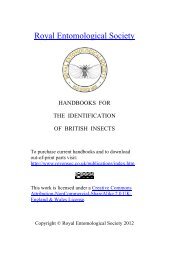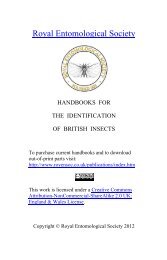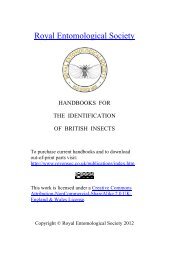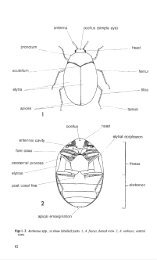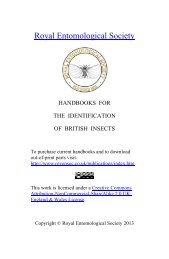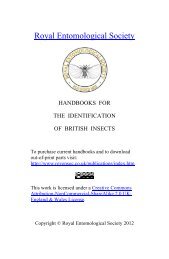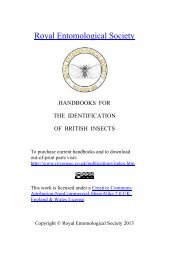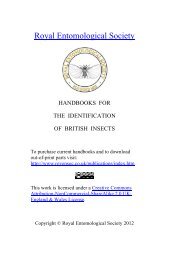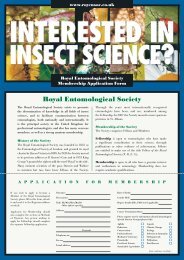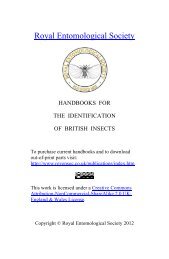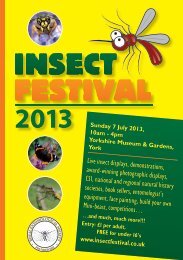Vol 10 Part 14. An introduction to the immature stages of British Flies ...
Vol 10 Part 14. An introduction to the immature stages of British Flies ...
Vol 10 Part 14. An introduction to the immature stages of British Flies ...
Create successful ePaper yourself
Turn your PDF publications into a flip-book with our unique Google optimized e-Paper software.
sizes and some <strong>of</strong> each kept alive for possible rearing <strong>to</strong> adult in order <strong>to</strong> establish<br />
identity. Pupae or puparia should be kept alive.<br />
Glass or plastic tubes or tins are suitable containers for keeping terrestrial larvae<br />
alive, <strong>to</strong>ge<strong>the</strong>r with some <strong>of</strong> <strong>the</strong> pabulum in which <strong>the</strong>y were found. Aquatic larvae<br />
should be placed in suitable jars or bottles. Larvae suspected <strong>of</strong> being carnivorous<br />
should be kept singly.<br />
Useful equipment for collecting terrestrial larvae includes a small trowel for soil<br />
sampling, a strong knife for splitting bark, wood, etc., a sieve or nest <strong>of</strong> sieves <strong>of</strong> graded<br />
mesh size, forceps, a fine paint brush (for tiny delicate larvae), a white sheet or dish for<br />
sorting, a notebook, adhesive labels and pencil. A pooter or insect aspira<strong>to</strong>r could be<br />
useful in some dry situations but must be <strong>of</strong> <strong>the</strong> 'blow' type <strong>to</strong> avoid health hazards (see<br />
section on Medical Importance).<br />
For aquatic species a strong metal-framed pond net is essential; a wire hook for<br />
securing weed is useful and a strong stick for turning s<strong>to</strong>nes and a large white tray for<br />
sorting.<br />
A useful way <strong>of</strong> sorting soil indoors is by floatation in which <strong>the</strong> sample is immersed<br />
and broken up in a solution <strong>of</strong> magnesium sulphate (Epsom salts) at a strength <strong>of</strong> about<br />
one pound (0.488 kilo) <strong>to</strong> one gallon (4.55litres) <strong>of</strong> water. The larvae float on <strong>the</strong><br />
surface (puparia <strong>of</strong>ten around <strong>the</strong> edges) and should be picked <strong>of</strong>f quickly as this<br />
solution can anaes<strong>the</strong>tise aquatic animals. <strong>An</strong> alternative solution can be made using<br />
some common salt in water. The floatation methods only work for free-living larvae<br />
and are no substitute for careful hand searching which may also yield larvae hidden in<br />
cocoons and silken tubes.<br />
Soil-dwelling species may be sampled by using a solution <strong>of</strong> orthodichlorobenzene<br />
(Jeyes' Fluid). About half-an-ounce (14 g) <strong>of</strong> <strong>the</strong> liquid <strong>to</strong> one gallon <strong>of</strong> water is poured<br />
on cleared ground at <strong>the</strong> rate ·<strong>of</strong> 2 gallons (9.1 litres) <strong>of</strong> <strong>the</strong> mixture per square yard<br />
(0.83 sq. m). <strong>An</strong>y larvae should surface before half an hour or so (see Brindle & Smith,<br />
in Stubbs & Chandler, 1978).<br />
Fur<strong>the</strong>r information on collecting and equipment is given in Oldroyd (1970a),<br />
Brindle & Smith (in Stubbs & Chandler, 1978), Cogan & Smith (1974) and Southwood<br />
(1978).<br />
Rearing is only <strong>of</strong> value if <strong>the</strong> larvae or puparia are segregated in<strong>to</strong> suitable individual<br />
containers so that <strong>the</strong> <strong>immature</strong> <strong>stages</strong> can be linked <strong>to</strong> <strong>the</strong> subsequent adult and<br />
identification confirmed. As far as possible <strong>the</strong> conditions in which <strong>the</strong> larvae were found<br />
shou"td be re-created in miniature, especially humidity. Humidity or moisture gradients<br />
can be achieved by tilting containers containing moss, soil and a little water so that subaquatic<br />
larvae can choose <strong>the</strong> level that best suits <strong>the</strong>m. A range <strong>of</strong> plant (or animal) food<br />
collected in <strong>the</strong> larval habitat should be provided as possible food for <strong>the</strong> larvae, care<br />
being taken not <strong>to</strong> introduce anything likely <strong>to</strong> prey upon <strong>the</strong> larva. Close observation<br />
and care is necessary until it is clear that <strong>the</strong> conditions provided are satisfac<strong>to</strong>ry.<br />
Containers can vary from tins, gauze <strong>to</strong>pped tubes or jars, petri dishes, etc., whichever<br />
seems best <strong>to</strong> fit <strong>the</strong> particular moisture requirement without encouraging mould.<br />
Rearing larvae <strong>of</strong> unknown habits and identity is not easy but <strong>the</strong> interest and<br />
satisfaction <strong>of</strong> possibly establishing a new life-his<strong>to</strong>ry and describing a hi<strong>the</strong>r<strong>to</strong><br />
unknown larva is sufficient reward for making <strong>the</strong> attempt. Wong (1972) reviews<br />
rearing techniques.<br />
Larvae selected for preservation are best killed in hot (60-70oC) water if this is<br />
available. This also expands <strong>the</strong> larvae which can <strong>the</strong>n be placed and s<strong>to</strong>red in 80%<br />
alcohol with a little glycerine added <strong>to</strong> guard against drying out through evaporation.<br />
A better medium for preservation is Berlese preservative which is prepared in a similar<br />
way <strong>to</strong> Berlese mountant (see below), but without gum arabic. This is a clear fluid that<br />
does not set and specimens may be kept in it indefinitely and mounted as required. If it<br />
thickens because <strong>of</strong> evaporation it can easily be thinned with small amounts <strong>of</strong> distilled<br />
water.<br />
22




